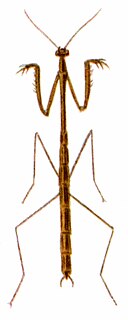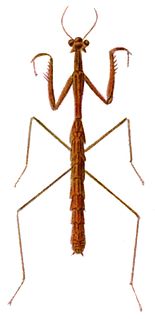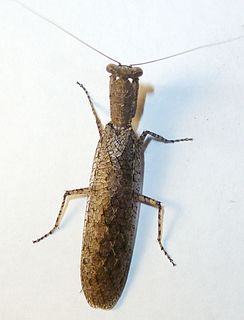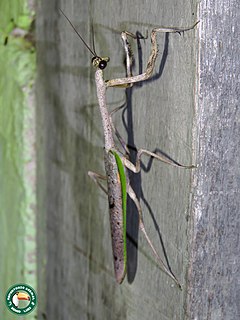
The Carolina mantis is a species of praying mantis of the subfamily Stagmomantinae.

The Chinese mantis is a species of mantis native to Asia and the nearby islands. In 1896 this species was accidentally introduced by a nurseryperson at Mt. Airy near Philadelphia, United States. Tenodera sinensis often is erroneously referred to as Tenodera aridifolia sinensis because it was at first described as a subspecies of Tenodera aridifolia, but Tenodera sinensis is now established as a full species.

Iris oratoria, known by the common name Mediterranean mantis or iris mantis, is a widespread species of praying mantis native to Europe. It is found as an introduced species in the Middle East, Western Asia and the United States. Iris oratoria invaded southern California in the 1930s and seems to be spreading.

Choeradodis is a genus of praying mantises with common names such as shield mantis, hood mantis, and leaf mantis because of their extended, leaf-like thoraces. The distinguishing characteristic of Choreododis from which it takes its common names is a laterally expanded thorax. This adaptation for the purpose of camouflage, as well as a rounded wing case and a habit of staying relatively flattened, aid its leaf mimicry.

Archimantis latistyla, commonly known as the large brown mantis is a species of mantid native to Australia. The large brown mantis has two subspecies, a widespread subspecies and the stick mantis ghost from Bundabergs Turtle Sands. The stick mantis ghosts are not as aggressive as the widespread species but have a defense display used to make the mantis appear larger by flinging its front legs into the air and putting its head down along with its antennae. Large brown mantids are light brown with short winged female and a long winged male. The subspecies from Bundaberg is a pale cream white with a yellow and black eye in between the arms. The large brown mantis female is short winged - her wings reach only half her abdomen and she is not able to fly—but the long winged male has wings that cover the entire abdomen. They have two pairs of wings - the top pair are the wing covers and the bottom wings enable the mantis to fly.

Phyllocrania paradoxa, common name ghost mantis, is a small species of mantis from Africa remarkable for its leaf-like body. It is one of the three species in the genus Phyllocrania. It is known for its distinct and exclusive camouflaged appearance of a dry weathered leaf.

Brunneria borealis, common name Brunner's mantis, Brunner's stick mantis, or northern grass mantis, is a species of praying mantis native to the southern United States. It is the only mantis species known to reproduce solely through parthenogenesis; there are no males.

Thesprotia graminis, common name American grass mantis or grass-like mantis, is a species of praying mantis native to the Southern United States. It is found in Florida and Georgia. This species can reproduce parthenogenetically or through sexual reproduction. T. graminis is similar in appearance to Brunneria borealis.

Sphodromantis viridis is a species of praying mantis that is kept worldwide as a pet. Its common names include African mantis, giant African mantis, and bush mantis.
Deroplatys desiccata, known by the common name giant dead leaf mantis, is a praying mantis from Southeast Asia. This is the type species of genus Deroplatys.

Dead leaf mantis is a common name given to various species of praying mantis that mimic dead leaves. It is most often used in reference to species within genus Deroplatys because of their popularity as exotic pets. Examples include D. desiccata, D. lobata, and D. philippinica. Other species to which the term may apply include Acanthops falcataria, A. falcata, and Phyllocrania paradoxa.

Brunneria is a genus of praying mantises in family Mantidae. They are often called stick mantis for their slender shape and the species of the genus are native to the Americas.

Stick mantis and twig mantis are common names applied to numerous species of mantis that mimic sticks or twigs as camouflage. Often the name serves to identify entire genera such as is the case with:

Stagmomantis limbata, common name bordered mantis, bosque mantis, Arizona mantis, or New Mexico praying mantis, is a species of praying mantis native to North America, most prevalent in the south-western United States. This beneficial insect is green or beige in color and grows up to around 3 inches long.
Grass mantis is a common name mostly given to various species of praying mantis that mimic grass or other slender vegetation. Species to which this name has been applied include but are not limited to:

Bolbe pygmaea is a species of praying mantis in the genus Bolbe in the family Iridopterygidae of the order Mantodea. It is endemic to Australia.

The bark mantises and ground mantises are praying mantids now placed in the family Eremiaphilidae that are native to the Afrotropics. They are generally light brown but more silvery on the wings. The wings are attractively reticulated, and the veins may be mottled dark and pale. The head is wider than the pronotum, which is rounded anteriorly, and doesn't overlap with the rear of the head. The pronotum is depressed, with its sides more or less parallel, and only a weak supra-coxal bulge is present. The anterior tibia are flattened and greatly expanded longitudinally, and the tibial claw does not fit into a pit between the 1st and 2nd external spines of the anterior femora, as in a few mantis groups.

Mantises are an order (Mantodea) of insects that contains over 2,400 species in about 430 genera in 30 families. The largest family is the Mantidae ("mantids"). Mantises are distributed worldwide in temperate and tropical habitats. They have triangular heads with bulging eyes supported on flexible necks. Their elongated bodies may or may not have wings, but all Mantodea have forelegs that are greatly enlarged and adapted for catching and gripping prey; their upright posture, while remaining stationary with forearms folded, has led to the common name praying mantis.

Pseudovates is a genus of praying mantis in the family Mantidae. There are more than 20 described species in Pseudovates, found in North, Central, and South America.















